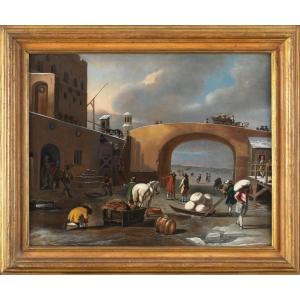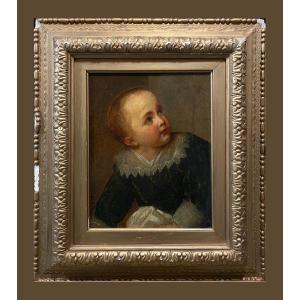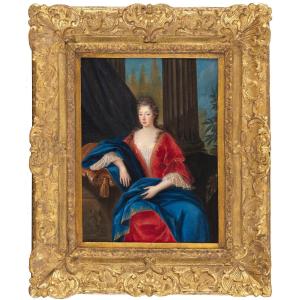This portrait is as much the expression of the individual desire of a lady to appear in her most beautiful finery as it is the reflection of the taste of an era which had made Antiquity the pillar of arts and letters under the impetus of Sun King. Thus our young woman presents herself in a most antique setting, her arm resting on an architectural element decorated with a bas-relief representing the Greek myth of Pan and Syrinx, namely the legend of a nymph trying to escape the devouring passion of a satyr. Is this a wink that our model addresses to the viewer who, like Pan, will only be able to appreciate it with their eyes because they cannot embrace it? These intellectual games are witnesses of a refined society in which the exchange of portraits is an integral part of a gallantry in which women occupy the leading role.
Our delicate portrait is highlighted by a Louis XIV frame in carved and gilded wood.
Dimensions: 29 x 22 cm – 45.5 x 37.5 cm with the frame
Sold with invoice and certificate
Concerned with detail as well as the atmosphere of his composition, our painter redoubles his virtuosity in the execution of the toilet of his model and the fabrics on which she lounges. The shimmer of the draperies and the fine impastos used to materialize lace and golden embroidery are characteristic of the art of François de Troy to whose entourage we link this painting. The “fontange” hairstyle worn by our lady and the saturated colors of the materials place us at the end of the Grand Siècle, in a manner close to that implemented by François de Troy in his Portrait of the Duchess of Maine as Cleopatra produced around 1690 (preserved at the Palace of Versailles Museum). If the position adopted by our model recalls that of Louise Hippolyte Grimaldi in a portrait painted by de Troy in 1715 (kept at the Louvre Museum), the presence of ancient architectural elements punctuates numerous other works by the Toulouse painter. In this regard, we can cite the sphinx adorning his Portrait of the Duchess of Force (kept at the Museum of Fine Arts in Rouen) or the statue decorating his Portrait of the Princess Palatine (kept at the Museum of Fine Arts of Orléans). Like our painting, these two compositions open onto landscapes which are invitations to bucolic walks and daydreaming.
Biography: François de Troy (Toulouse January 9, 1645 – Paris, May 1, 1730) was born into a family of glaziers and embroiderers. We know nothing of his Toulouse childhood. Perhaps he learned painting from his father, Antoine, who also practiced the art of portraiture. His installation in Paris between 1662 and 1668 allowed him to train with Claude Lefebvre and Nicolas-Pierre Loir, who gradually introduced him to the court. Approved by the Royal Academy in 1669, he was officially accepted there in 1674 as a history painter. However, it was the genre of portraiture that earned him his fame and to which he devoted himself fully from 1675. Building on his success, François de Troy progressed in the hierarchy of the Academy, becoming professor in 1693, then director in 1708 and finally assistant rector in 1722. André Bouys, Hubert Drouais and his own son, Jean-François de Troy, received his teachings there. Having experienced the reigns of Louis XIV and Louis XV, François de Troy remains one of the most famous portraitists of the French Baroque, alongside Nicolas de Largillière and Hyacinthe Rigaud.
Biography:
- AUBERT, Jean, Faces of the Grand Siècle: French portraiture under the reign of Louis Augustins, October 8, 1997 - January 5, 1998), Somogy, 1997. - - BREME, Dominique, François de Troy, 1645-1730, (exp. cat., Toulouse, Paul Dupuy museum, April 7 - July 7, 1997), Paris, Somogy , 1997.
- KIRCHNER, Thomas, Ups and downs of portraiture in 17th century France, Paris, Fondation maison des sciences de l'homme German Center for the History of Art, 2022.
- BREME Dominique, JAMES-SARAZIN Ariane, Portraits in majesty François de Troy, Nicolas de Largillière, Hyacinthe Rigaud (catalogue of the exhibition in Perpignan, Hyacinthe Rigaud Art Museum, June 26 – Nov. 7, 2021). Silvana Editorial, 2021.
























 Le Magazine de PROANTIC
Le Magazine de PROANTIC TRÉSORS Magazine
TRÉSORS Magazine Rivista Artiquariato
Rivista Artiquariato
